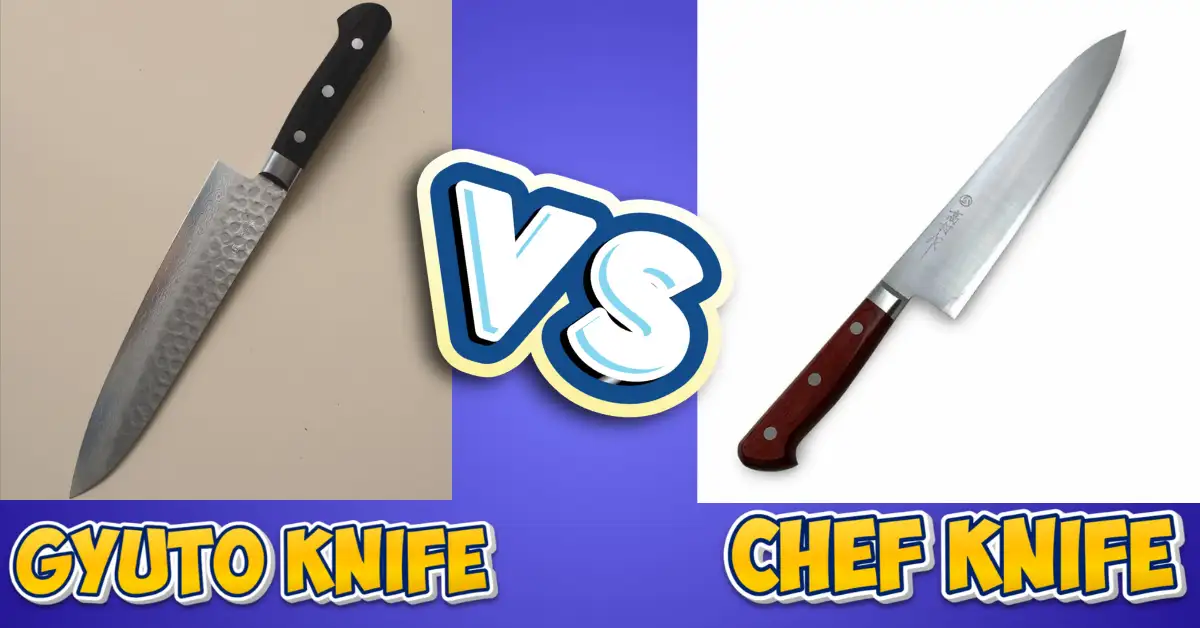Ever stood at the cutting board and wondered if you’re using the right knife? I’ve been there too—chopping, slicing, and thinking about what really makes one blade better than another. After years in the kitchen, I’ve had time to explore the gyuto knife vs chef knife debate firsthand.
These two stars may look similar, but they each bring something different to the table. I’ll walk you through what I’ve learned, what stood out, and where each knife shines. Stick around—this might help you choose your next favorite kitchen tool. Let’s get into it.
Table of Contents
Gyuto Knife Review
I’ve been using gyuto knives for over three years now in my home kitchen, and they’ve truly changed the way I prep and cook.
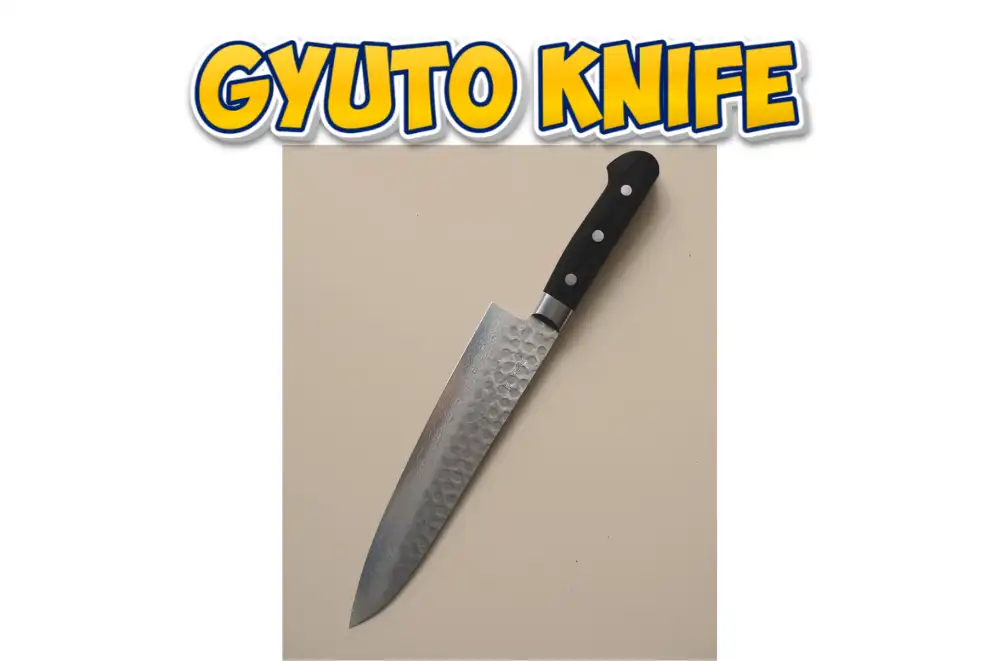
What I Like
Sharing the best things I’ve noticed about gyuto knives from my time using them in everyday cooking.
- Versatile for everything: Whether I’m slicing tomatoes or trimming a roast, the gyuto knife handles it all. It’s like having a chef’s knife with superpowers—balanced and ready for almost any kitchen task.
- Thin, sharp edge: The fine edge glides through food with barely any effort. It makes prep work smoother, especially when I’m trying to slice onions paper-thin or dice veggies fast.
- Comfortable to hold: Many gyuto knives have a handle that fits well in my hand. Even after 30 minutes of prep, I don’t feel tired—just focused on the food.
- Light but strong: It’s lighter than many Western knives, but still feels solid. That gives me more control, especially when doing small, clean cuts.
- Easy to maintain: A quick hone now and then keeps it sharp. When it does need sharpening, the steel responds fast—no stress, no special tools.
What Could Be Better
While I love using gyuto knives, a few small things could be improved to make the experience even better.
- Not for cutting bones: I don’t use it to break down chicken or frozen meat. It’s made for clean slicing, not heavy chopping—and that’s okay.
- Edge can chip if mistreated: The blade is very sharp, but that means it can be delicate. I never use it on glass or stone boards and always handle it with care.
- Some models need regular honing: Depending on the steel, some need more upkeep. It’s not hard, but it’s something to remember if you’re used to low-maintenance knives.
- Handle styles vary: Some gyuto knives have thin Japanese handles that may feel new at first. It took me time to adjust, but now I like the balance and control.
My Personal Experience
I’ve been using gyuto knives almost daily for more than three years. It’s my favorite knife for everything from quick dinners to weekend meal prep.
Design
Here’s how it looks, feels, and fits into my daily kitchen routine.
The design of the gyuto knife is what drew me in first—it’s sleek, simple, and feels refined. The blade tapers smoothly and has that classic Japanese shape I admire. It doesn’t feel bulky or clunky like some Western knives I’ve used. It’s light, but not too light, and moves naturally with my hand. I can slice, dice, and chop without fighting the knife. Honestly, it made me enjoy prep work more than I expected.
Performance
How it handles real-world cooking tasks, from chopping veggies to slicing meat.
This is where the gyuto really stands out. It’s sharp—so sharp that it makes clean cuts with little effort. I notice the difference when I’m slicing tomatoes or fresh herbs. There’s no tearing, just smooth motion. I don’t have to press hard or see through food. It gives me confidence in the kitchen because it does exactly what I want, every time. It’s fast, clean, and even fun to use.
Build Quality
Looking at the materials, craftsmanship, and long-term reliability.
Most gyuto knives I’ve tried are made with high-carbon steel or a strong stainless blend. The blade holds its edge and resists rust well, as long as I wash and dry it right after use. The handle is smooth and secure, whether it’s wood or resin. I’ve used mine for years, and it still looks and works great. Compared to basic knives I owned before, this feels like a huge upgrade. It’s the kind of tool that earns its spot in your kitchen.
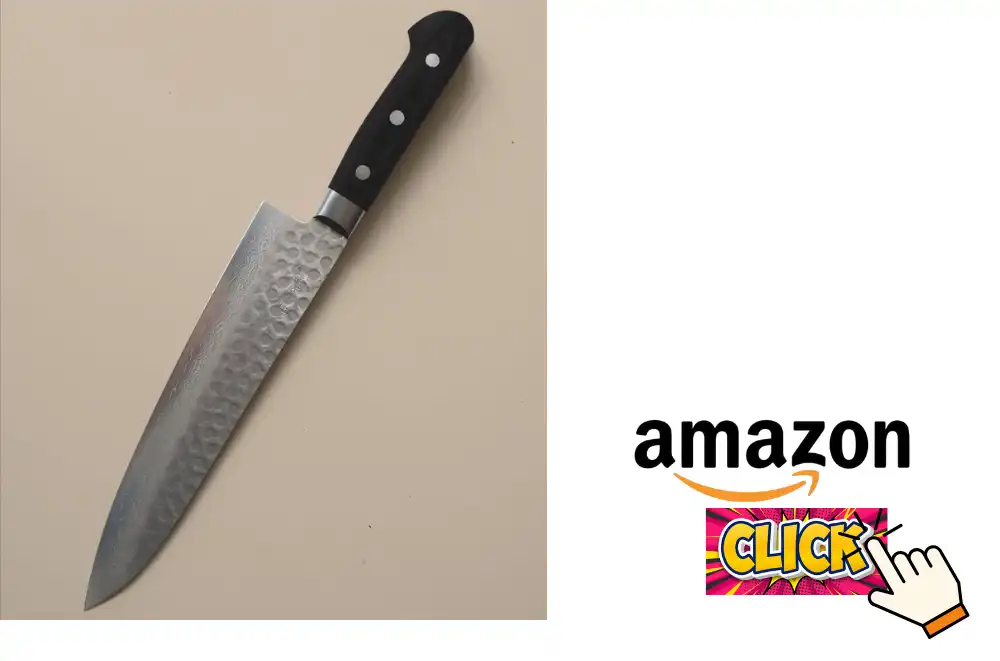
Check Latest Price and Offer at Amazon
Chef Knife Review
I’ve been using this chef knife every day in my home kitchen, and it’s quickly become my favorite tool. It makes prep work faster, cleaner, and a lot more fun.
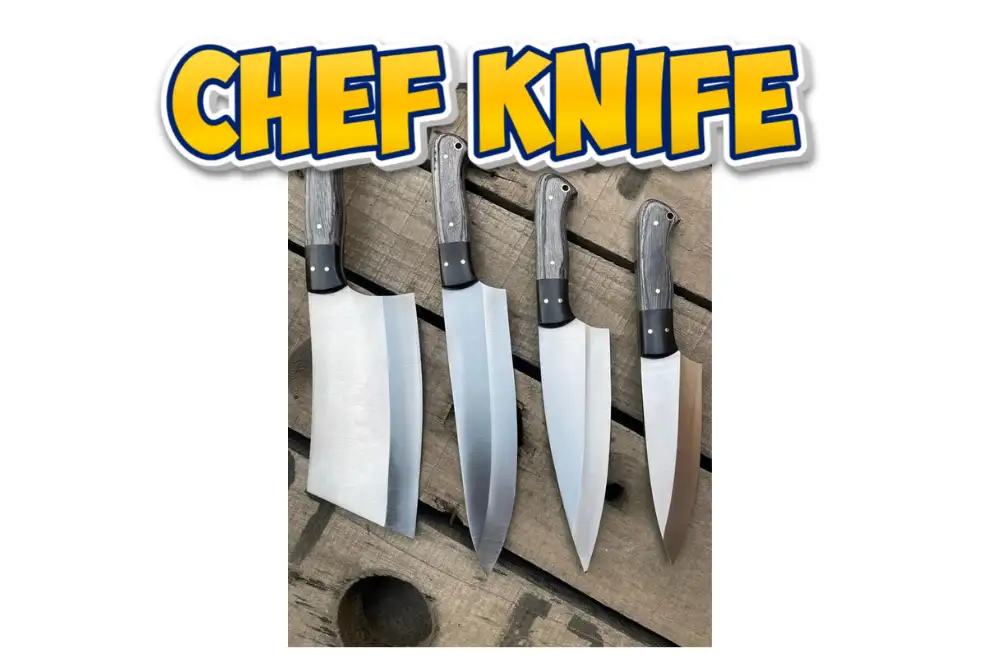
What I Like
I’ve spent a lot of time in the kitchen, and these are the reasons this knife stands out for me.
- Effortless Precision: The blade is razor-sharp. It slices onions, carrots, and even tomatoes without squishing them. Cutting feels smooth and easy.
- Comfortable Handle: The handle fits just right. I can chop for long stretches without pain or slipping. It feels natural and steady.
- Balanced Weight: It’s not too light or too heavy. The balance makes it easy to control. Chopping and slicing feel more accurate.
- Stays Sharp for Weeks: I don’t have to sharpen it often. Even after lots of use, it still cuts like new. That saves time and effort.
- Works for Everything: I use this knife for meat, herbs, fruit, and more. It’s my go-to for almost any task in the kitchen.
What Could Be Better
While I love this knife, there are a few things I wish were a bit easier. Nothing major—just small things worth knowing.
- Hand-Wash Only: You can’t toss it in the dishwasher. A quick hand wash keeps it in shape, though it adds one small step.
- A Bit Pricey for Beginners: It costs more than basic knives. But for the quality and how long it lasts, I think it’s worth it.
- Takes Some Getting Used To: It’s very sharp, which can feel scary at first. But once I got the hang of it, I wouldn’t go back.
My Personal Experience
I’ve used this brand of chef knives for over two years. It’s now the first thing I reach for when cooking.
Design
The moment I held it, I could tell it was made with care. It looks clean and feels just right in my hand.
The handle fits my palm well. It’s smooth but not slippery. The blade has a simple, sharp design that feels high-end. It’s the kind of tool that makes you feel more confident in the kitchen. I’ve used dull, clunky knives before—this one feels like an upgrade in every way.
Performance
This knife has made prep work quicker and cleaner. It cuts better than any knife I’ve used before.
From soft fruit to tough root veggies, it glides right through. The edge stays sharp, even after long cooking sessions. I use it for big meals and small snacks. It just works, and it works well. I don’t waste time sawing through food anymore.
Build Quality
I’ve dropped it, bumped it, and used it almost every day—and it’s still going strong.
The steel hasn’t chipped or rusted. The handle has no cracks or wobbles. It feels strong and made to last. I had cheaper knives before that fell apart in months. This one feels like it will stay with me for years.
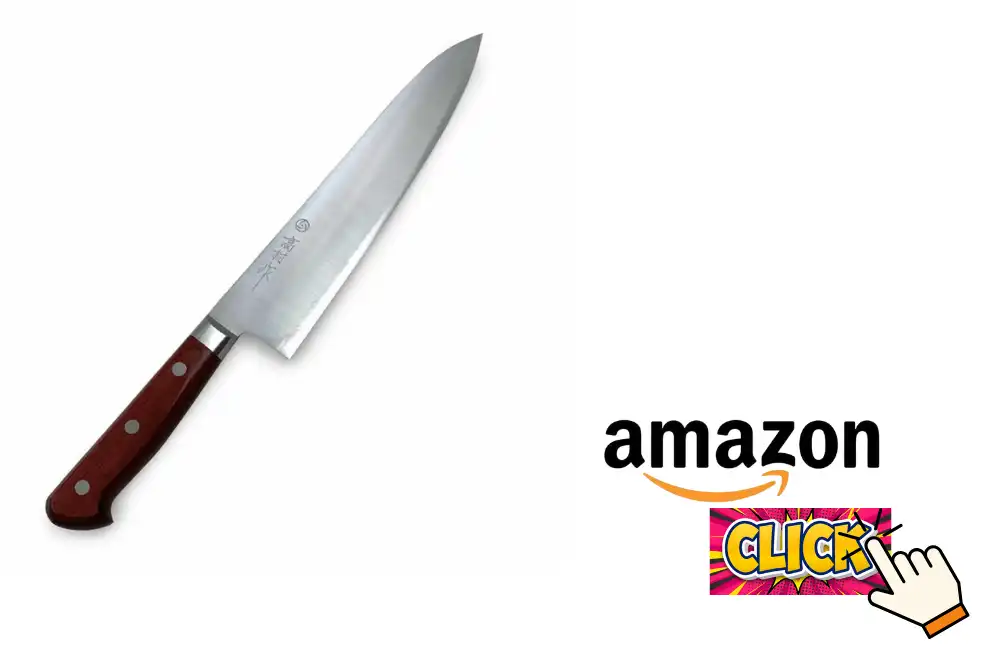
Check Latest Price and Offer at Amazon
Gyuto knife vs Chef knife: Details Comparison
I’ve been testing both gyuto knives and chef knives for years in my kitchen. Each has its strengths, and both have made cooking easier and more enjoyable. Here’s a full comparison based on real use.
Blade Material: gyuto knife vs chef knife
Both knives use high-quality steel, but the gyuto often uses harder steel for a finer edge. Chef knives usually have softer steel that’s easier to sharpen.
| Feature | Gyuto Knife | Chef Knife |
| Steel Type | High-carbon or stainless blends | Stainless or high-carbon steel |
| Edge Retention | Excellent with proper care | Good, easier to hone |
| Rust Resistance | Needs more care | More forgiving |
Gyuto Knife Rating: 9/10
Chef Knife Rating: 8.5/10
The Size of the Knives: gyuto knife vs chef knife
Gyuto knives tend to be slimmer and come in a range of sizes. Chef knives are broader, with common lengths around 8 inches.
| Feature | Gyuto Knife | Chef Knife |
| Common Length | 210mm–240mm (8.2″–9.4″) | 8″ standard |
| Blade Height | Lower blade profile | Taller blade |
Gyuto Knife Rating: 8.5/10
Chef Knife Rating: 9/10
The Shape of the Blade: gyuto knife vs chef knife
The gyuto has a gentle curve and slimmer blade. Chef knives have a deeper belly and wider tip, great for rocking cuts.
| Feature | Gyuto Knife | Chef Knife |
| Blade Curve | Subtle for slicing and push cuts | Pronounced for rocking motion |
| Shape Feel | Sleek and agile | Broad and powerful |
Gyuto Knife Rating: 9/10
Chef Knife Rating: 9/10
Tip of the Knife: gyuto knife vs chef knife
Gyuto knives often have a sharper, finger tip, good for detail work. Chef knives have a rounder, stronger tip.
| Feature | Gyuto Knife | Chef Knife |
| Tip Style | Pointed for precision | Rounded for strength |
| Fine Control | Great for detail work | Strong for general use |
Gyuto Knife Rating: 9/10
Chef Knife Rating: 8/10
The Handle: gyuto knife vs chef knife
Gyuto handles vary in style—some are slim and traditional, while others mimic Western styles. Chef knives usually have thicker, Western-style grips.
| Feature | Gyuto Knife | Chef Knife |
| Style | Wa-handle (Japanese) or Western | Full Western grip |
| Comfort | Light and precise | Sturdy and familiar |
Gyuto Knife Rating: 8.5/10
Chef Knife Rating: 9/10
Weight: gyuto knife vs chef knife
Gyuto knives are lighter and more nimble. Chef knives carry more weight, which helps with chopping harder foods.
| Feature | Gyuto Knife | Chef Knife |
| Average Weight | Light and agile | Medium-heavy for momentum |
| Cutting Feel | Fast and controlled | Strong and stable |
Gyuto Knife Rating: 9/10
Chef Knife Rating: 8.5/10
Grip Offered: gyuto knife vs chef knife
Both knives offer good grip, but chef knives are often more secure for larger hands. Gyuto knives may take time to adjust to.
| Feature | Gyuto Knife | Chef Knife |
| Grip Comfort | Lightweight, needs finesse | Ergonomic and firm |
| Slip Resistance | Good with proper handle material | Excellent with molded handles |
Gyuto Knife Rating: 8/10
Chef Knife Rating: 9/10
Sharpening the Knives: gyuto knife vs chef knife
Gyuto knives stay sharp longer but need careful sharpening. Chef knives are easier to maintain and hone.
| Feature | Gyuto Knife | Chef Knife |
| Sharpening Ease | Needs skill and care | Quick and simple |
| Honing Frequency | Less frequent with hard steel | More frequent but easy |
Gyuto Knife Rating: 8.5/10
Chef Knife Rating: 9/10
The Finishing of the Knives: gyuto knife vs chef knife
Gyuto knives often have a polished, elegant finish. Chef knives focus on durability and grip.
| Feature | Gyuto Knife | Chef Knife |
| Visual Appeal | Sleek, clean lines | Practical, sometimes textured |
| Feel | Smooth and refined | Grippy and robust |
Gyuto Knife Rating: 9/10
Chef Knife Rating: 8.5/10
Durability: gyuto knife vs chef knife
Chef knives are more forgiving of rough use. Gyuto knives need more care but last long with proper handling.
| Feature | Gyuto Knife | Chef Knife |
| Wear Resistance | Excellent with gentle care | Very durable |
| Long-Term Use | High if treated well | Built to endure daily abuse |
Gyuto Knife Rating: 8.5/10
Chef Knife Rating: 9/10
Versatility: gyuto knife vs chef knife
Both knives can handle a range of kitchen tasks, though the gyuto offers more finesse, and the chef knife handles tougher jobs better.
| Feature | Gyuto Knife | Chef Knife |
| Prep Flexibility | Great for slicing and dicing | Great for chopping and slicing |
| Task Range | Light meats, veggies, herbs | All-purpose, even harder foods |
Gyuto Knife Rating: 9/10
Chef Knife Rating: 9/10
Cost: gyuto knife vs chef knife
Gyuto knives can be more expensive, especially for handmade options. Chef knives range widely but tend to be more budget-friendly.
| Feature | Gyuto Knife | Chef Knife |
| Price Range | Mid to high | Low to mid |
| Value for Money | Excellent for enthusiasts | Great for beginners and pros |
Gyuto Knife Rating: 8/10
Chef Knife Rating: 9/10
Final Thoughts
The gyuto knife is like a sports car—fast, sharp, and made for control. The chef knife is your solid all-rounder—reliable and built to handle anything you throw at it. Both are strong choices. It really comes down to what kind of cook you are and how you like to work in your kitchen.

FAQ: Gyuto knife vs Chef knife
What’s the difference between a gyuto knife and a chef knife?
A gyuto is lighter and thinner, great for precise cuts. A chef knife is heavier and more robust. Learn more about which suits your style.
Is a gyuto knife good for everyday cooking?
Yes! It’s sharp, light, and handles most tasks with ease. Great for slicing, chopping, and even detail work. Explore how it compares in real use.
Which knife is better for beginners—gyuto or chef knife?
Chef knives feel familiar and sturdy. Gyuto knives may take a bit to adjust to but offer great control. Learn more to find your best fit.
Can I use a gyuto knife like a chef knife?
Absolutely. The gyuto is Japan’s answer to the Western chef knife—versatile and kitchen-ready. Discover what sets them apart in daily prep.
Are gyuto knives more delicate than chef knives?
They can be. The thin edge can chip if misused. Chef knives are tougher but less precise. Learn more about how to care for both.

